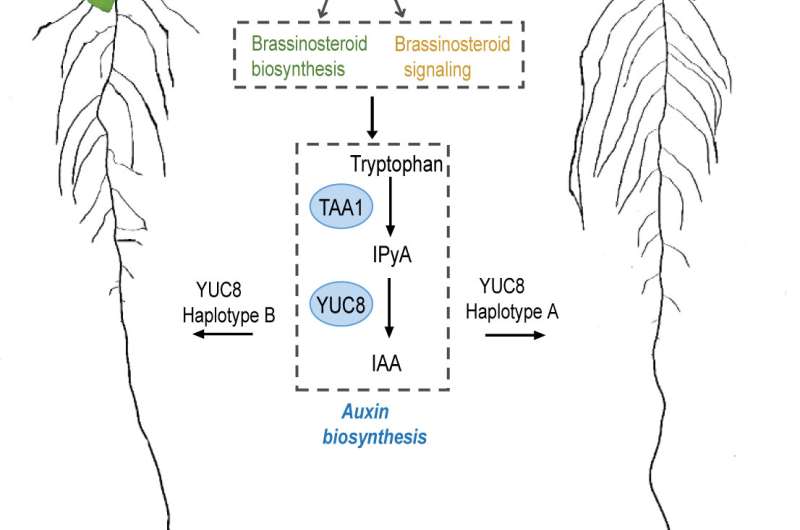Researchers discover hormonal regulatory module for root elongation

In future, agricultural crop production will have to manage with less and less nitrogen fertilization. The goal must therefore be to increase nitrogen use efficiency so that yield levels can be kept stable. Plants respond to mild nitrogen deficiency by elongating their lateral roots. In this way, more nitrogen can be absorbed than before. Researchers at the IPK Leibniz Institute have now discovered a hormonal regulatory module that mediates the molecular processes of this adaptation. Brassinosteroids and auxins play a central role in this. The results were published in the journal Nature Communications.
It is vital for plants to be able to adapt their root structure to changes in the soil. If there is a slight lack of nitrogen, many plants elongate their lateral roots. The hormone auxin plays an important role in root formation. When nitrogen supply is adequate, enough auxin is transported from the shoot to the roots for them to grow. "However, if there is a moderate lack of nitrogen, shoot-derived auxin is not enough for adaptation; thus local biosynthesis of auxin is strongly enhanced in the root tip," explains Prof. Dr. Nicolaus von Wirén, head of the Department of Physiology and Cell Biology at the IPK Leibniz Institute.
But it is not only about auxin; brassinosteroids also have an important function in this process. They are synthesized to a greater extent in the event of mild nitrogen deficiency and are passed on as a growth-promoting signal. "This signal in turn is necessary to induce the two genes TAA1 and YUCCA8 in the roots," explains Dr. Zhongtao Jia, first author of the study. "Thereby, the formation of auxin is controlled and regulated according to the respective nitrogen demand. Ultimately, the elongation of the lateral roots is increased in this way."

"In our study, we have thus discovered a hormonal regulatory module. What is new is that we can arrange the hormones in hierarchical order, i.e., brassinosteroids are upstream of auxin in this process," says Prof. Dr. Nicolaus von Wirén. But not only that: The IPK scientists also found allelic variations in the YUCCA gene during their research on the model plant Arabidopsis. "These are related to the fact that some natural accessions (lines of certain geographical origin) show a stronger elongation of the lateral roots than others when grown under mild nitrogen deficiency."
The next challenge is to use these findings for further genetic improvement of crop plants—for example, by developing genetic markers or by gene editing employing the CRISPR/Cas technology. "We also expect such differences between individual lines in the barley or wheat accessions in our gene bank," says Prof. Dr. Nicolaus von Wirén. In addition, the IPK researchers want to investigate the questions of how plants can measure their internal nitrogen nutritional status and which factors might play a role in the process of root elongation even before brassinosteroids come into play.
More information: Zhongtao Jia et al, Local auxin biosynthesis acts downstream of brassinosteroids to trigger root foraging for nitrogen, Nature Communications (2021). DOI: 10.1038/s41467-021-25250-x
Journal information: Nature Communications
Provided by Leibniz Institute of Plant Genetics and Crop Plant Research


















